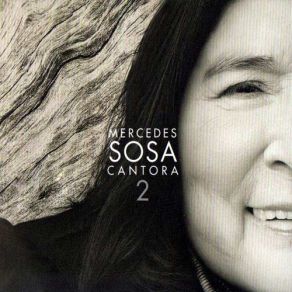Cantora 2
Download links and information about Cantora 2 by Mercedes Sosa. This album was released in 2009 and it belongs to Latin genres. It contains 18 tracks with total duration of 01:12:45 minutes.

|
|
|---|---|
| Artist: | Mercedes Sosa |
| Release date: | 2009 |
| Genre: | Latin |
| Tracks: | 18 |
| Duration: | 01:12:45 |
| Buy it NOW at: | |
| Buy on Songswave €2.46 | |
| Buy on iTunes $13.99 | |
Tracks
[Edit]| No. | Title | Length |
|---|---|---|
| 1. | Zona De Promesas (featuring Gustavo Cerati) | 4:01 |
| 2. | Desarma Y Sangra (featuring Charly Garcia) | 2:51 |
| 3. | Canción Para Un Niño De La Calle (featuring Calle 13) | 4:15 |
| 4. | Parao (featuring Vicentico) | 4:30 |
| 5. | Zamba Del Cielo (featuring Liliana Herrero, Fito Páez / Fito Paez) | 4:33 |
| 6. | Razón De Vivir (featuring Lila Downs) | 4:20 |
| 7. | El Ángel De La Bicicleta (featuring Gustavo Cordera) | 5:15 |
| 8. | Violetas Para Violeta (featuring Joaquín Sabina / Joaquin Sabina) | 4:16 |
| 9. | Jamás Te Olvidaré (featuring Marcela Morelo) | 3:29 |
| 10. | O Que Será (featuring Daniela Mercury) | 3:47 |
| 11. | Cantame (featuring Franco De Vita) | 3:44 |
| 12. | La Luna Llena (featuring La Chilinga, Rubén Rada / Ruben Rada) | 2:46 |
| 13. | Canción De Las Cantinas (featuring Alberto Rojo) | 4:54 |
| 14. | Donde Termina El Asfalto (featuring Coqui Sosa) | 3:26 |
| 15. | Insensatez (featuring Luis Salinas) | 3:22 |
| 16. | Misionera (featuring Luis Carlos Borges) | 5:10 |
| 17. | Y Asi Y Así (featuring Luciano Pereyra) | 3:32 |
| 18. | Himno Nacional Argentino (featuring Los Folkloristas) | 4:41 |
Details
[Edit]Cantora is Mercedes Sosa's first album for Sony, and it is clear the company pulled out all the stops in the conception and promotion of this ambitious project, a two-part album featuring 35 duets with a list of guests that reads like a who's-who of contemporary Latin American music. A world music diva of the stature of Edith Piaf, Mina, or Amália Rodrigues, Mercedes Sosa has always been revered by her colleagues, and considered a mandatory source of musical — if not often ideological, as well — inspiration for all Latin American singers. Thus, it is hardly surprising that Cantora, Vol. 1, released in March 2009, can boast of a lineup of artists such as Caetano Veloso, Joan Manuel Serrat, Jorge Drexler, Luis Alberto Spinetta, Shakira, Julieta Venegas, Gustavo Santaolalla, Nacha Roldán, and León Gieco, among many others. As with all projects of this kind, however, not every collaboration works on the same level. In this respect, highlights are probably up to the listener, according to how much he/she rates the guest in turn — it is hard to imagine longtime Sosa admirers caring much for her duets with young Latin pop stars, but fans of the latter may find their numbers a real treat. It would be inaccurate to blame the album's hiccups on the recording company's obvious design for maximum crossover, since Sosa has always shown a keen interest in trying different genres, as well as in fostering the work of new composers. Nevertheless, it is also true that she never sounds as comfortable as when she takes on her true province, Argentine folklore music. Contrary to the quintessential Sosa recordings, Cantora is a fairly subdued affair, with most songs whispered against unobtrusive yet tasteful acoustic arrangements by Poppi Spatocco. This is probably due to an effort to find a common ground between singers of very different registers. It certainly works very well, as it creates an encompassing sonic texture that helps to render the entire album less dissimilar than it may have been. Mercedes Sosa died in October 2009 after a long illness, and the effects of her illness are already in evidence in this project, as she is unable to sing at the peak of her otherworldly powers. Needless to say, she remains a class interpreter throughout the entire album, happy in the company of her obviously thrilled friends, admirers, and protégés, gathered throughout the course of an extraordinary lifetime. All together, they make Cantora into the moving farewell that it was probably conceived to be. Both Cantora volumes are also available together as a double-CD/DVD edition, with videos from the recording sessions